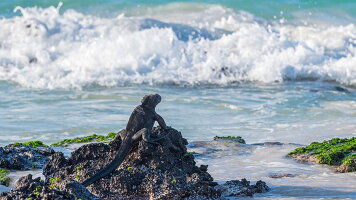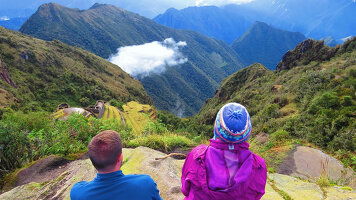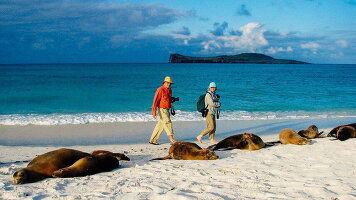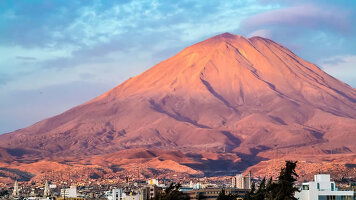Overview
Itinerary
Welcome to Quito, the capital of Ecuador. There's a free transfer from the airport to the hotel for all customers today, please read the joining instructions for more details. Stay: Hotel Vieja Cuba (or similar).
A short walking tour of Quito this morning is the perfect opportunity to meet your guide and get to know your fellow travellers. The heart of old Quito is a colonial masterpiece and the capital is widely regarded as one of the most beautiful cities in South America, as well as being a Unesco-listed site. Leaving Quito, we head to the Bellavista Cloud Forest on the northwestern slopes of the Andes. En route, we stop at the Intiñan Equator Museum, an interactive outdoors museum that sits directly on the middle of the earth.
Here, a guide takes us around the exhibits and we can do fun science experiments only possible at the equator, while also collecting a stamp in our passports to say we have been on the equatorial line. After, we continue to Bellavista. Situated at the top of the Tandayapa Valley, it is a private reserve bursting with orchids, bromeliads, toucans, tanagers and hummingbirds. The area is a paradise for naturalists with a vast network of hiking trails. Stay: Bellavista Cloud Forest Reserve & Lodge (or similar) (B/D).
We have an early start this morning to appreciate the diversity of Bellavista and spot some of the many resident bird species – there are 20 hummingbird species here alone! Following this morning's excursion, we drive towards northern Ecuador and the beautiful hacienda that will be our home for the next few nights. Stay: Hosteria Pantavi (or similar) (B/L).
After breakfast, we travel towards the foothills of the Imbabura Volcano where the indigenous community of San Clemente resides at 9,515ft (2,900m). The community consists of several families whose main livelihood is farming and agriculture. We have a guided tour by one of the families, who introduces us to native and medicinal plants, explains traditional embroidery techniques, tells us about their culture and shows us the day-to-day activities that take place here. A traditional lunch will be prepared using locally grown produce.
This afternoon, we drive back to our hacienda with the rest of the day free to relax in the beautiful gardens. Stay: Hosteria Pantavi (or similar) (B/L).
We start with a drive to Cuicocha Crater Lake at approximately 10,665ft (3,250m). This beautiful caldera (volcanic crater) is about 2mi (3km) wide and was formed more than 3,000 years ago by a massive volcanic eruption. We start with a scenic walk (up to three hours) along one section of the lake to take in the impressive scenery.
We then continue to Otavalo, which is situated in a valley at 7,380ft (2,250m) with a bustling indigenous market. There are many stalls and the local people wear colourful traditional clothing, a fantastic introduction to Andean life and a good place to pick up souvenirs. We have time to soak up the atmosphere before continuing to our overnight stay, a 400-year-old colonial hacienda. Stay: Hacienda San José de Puembo (or similar) (B).
A short drive over the dramatic (and breathless at 13,350ft/4,069m) Papallacta Pass. East of Quito, the Papallacta Hot Springs are regarded as the nicest in Ecuador. We have time to bathe in both hot and cold pools as the snow-capped Antisana Volcano looms over the horizon. We continue our journey, driving around the volcano flanks before a descent into the Amazon Basin to our rainforest lodge.
After a short briefing, we take a night walk to discover our new surroundings; there are fantastic night-time sounds to listen out for, a wonderful experience amid the rainforest humidity. Stay: Liana Lodge (or similar) (B/L/D).
Today we discover the Amazon Basin on foot, the incredible biodiversity explained by our indigenous guide. There is a good chance of seeing kingfishers, parrots, oropendolas and other bird species. We have a good chance of seeing squirrel and capuchin monkeys, although other larger mammals are considerably more shy and harder to spot. The insect life is also fascinating, with beautiful butterflies flashing by and army and leafcutter ants on patrol. We also visit the AmaZoonico Animal Rescue Centre where we can see some of the larger forest inhabitants, such as tapirs, capibaras, peccaries and various monkey species. Stay: Liana Lodge (or similar) (B/L/D).
We begin the wonderfully scenic drive west along the Road of the Waterfalls with spectacular views of the upper Amazon Basin and the Andes. The climb back to the highlands is mesmerising as we watch the ecology change and many waterfalls cascade from the high peaks into the lush valley of the Pastaza River.
There are good photo opportunities along the way, including a visit to the Pailon del Diablo (Devil's Cauldron) waterfall. We continue to Baños, a picturesque hot spring and pilgrim town adjacent to the 16,400ft (5,000m) tall Tungurahua volcano. In the late afternoon, we have a walking tour of Baños with an optional visit to the thermal baths. Stay: La Floresta Hotel (or similar) (B).
We drive to the Chimborazo region for a short walk (around two hours) in Chimborazo National Park, climbing from 15,090ft to 16,400ft (4,600m to 5,000m). Given the altitude, we take the climb slowly with plenty of stops to enjoy the view. Due to the equatorial bulge, the Chimborazo summit is the furthest place from the centre of the earth. In the national park, there are good possibilities to observe vicuñas, a relative of the llama.
This afternoon, we continue south to Riobamba. Stay: Hacienda Abraspungo (or similar) (B).
We have an early start today as we head to Cuenca, stopping to visit the Balbanera Church before continuing to Ingapirca, the largest Inca ruins in Ecuador. The Inca empire stretched along the Andes north through Ecuador into Colombia and south through Peru and deep into Chile. Ingapirca has fine examples of their famed brickwork plus a solar observatory. We descend from the highlands to colonial Cuenca where we stay for the next two nights. Stay: Hotel Carvallo (or similar) (B).
Like the old centre in Quito, Cuenca is a Unesco World Heritage site and a charming place to explore. A guided tour this morning takes into the remarkably intact old town, where many artisans have taken up residence amid the narrow colonial streets and famous landmarks. The afternoon is free to discover the town at your own leisure. Stay: Hotel Carvallo (or similar) (B).
A short drive this morning brings us to Cajas National Park, known as the Gateway to the Snowy Mountains in Quichua. This is a stunning area of lofty peaks, lagoons, lakes and rivers amid pristine paramo vegetation. During a walk of around two hours, we may encounter some of the 125 bird species recorded here, such as yellow-billed pintails, Ecuadorian hillstars or violet-throated metaltails. We stay in a hotel close to Cajas National Park for our last night in the Andean Highlands. Stay: Hosteria Dos Chorreras (or similar) (B).
Today we visit two interesting artisan towns in the foothills of Cuenca. Our first stop is Gualaceo, known as the garden of the Azuay province for its exuberant flora with many exotic species of orchid. The markets here showcase artisanal fabric, such as ponchos made with pre-Hispanic Ikat techniques.
Next we'll visit Chordeleg, a picturesque town filled with silver shops - this area produces intricate jewellery and is famous for its delicate techniques such as filigree. It is also well known for ceramics, hand-made embroidery and other crafts.
Later we get together for a farewell dinner to look back on an adventure filled two weeks. Stay: Hotel Victoria (or similar) (B/L).
We transfer to Cuenca Airport to fly back to Quito. The trip ends at Quito Airport, where it's time to bid Ecuador and the rest of the group goodbye and begin our return journey home (B).
Trip Inclusions
- Marvel at the highlights of mainland Ecuador, a kaleidoscope of majestic scenery
- Visit colonial Quito, the Otavalo indigenous market and Cuenca's UNESCO reserve
- Stay overnight in the peaceful Bellavista Cloud Forest Reserve
- Spend two nights soaking up the sounds of the Amazon Rainforest
- Visit the ruins of Ingapirca and Cajas National Park
- 5 Superior nights (3 hotel, 2 hacienda), 8 Classic nights (2 hotel, 3 lodge, 3 hosteria)
- Travel by minibus and boat
- 13 breakfasts, five lunches, three dinners
- All transport and listed activities
- Tour leader throughout
- Arrival transfers
- Itinerary and inclusions are subject to change
- Price is for land, cruise and internal flights as specified. Flights not specified are not included
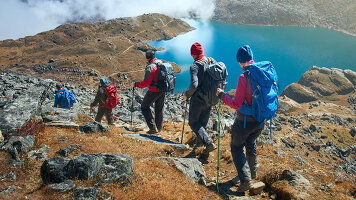
From classic small group tours & family adventures, to walking holidays, cycling trips and self-guided tours. Read more
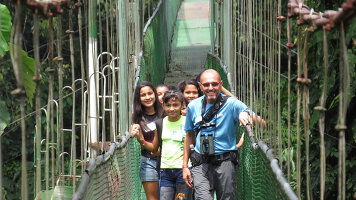
Exodus chooses their Leaders carefully. Professional, dedicated and are passionate about sharing their home countries. Read more
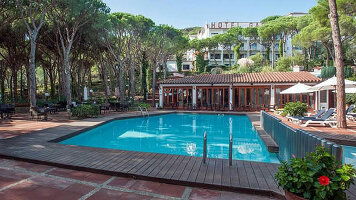
Wherever possible, Exodus chooses properties that are locally owned and that reflect the area you are visiting. Read more
Prices & Dates
There are currently no departures available on this trip. Either it's the end of the season and new departures will be released shortly, or this itinerary has been changed and is not operating this season. Feel free to contact us for information about when next seasons dates will be released or click here to view general release dates for all destinations.
Tour & cruises prices are per person. Prices shown have savings applied, are subject to availability and may be withdrawn at any time without notice. Pricing and trip details are correct at this point in time, however are subject to confirmation at the time of booking and are subject to change by Exodus. For cruise itineraries, cabin images are sourced from the cruise-line and should be treated as indicative only. Cabin inclusions, upholsteries and room layout may differ to the image(s) shown depending on the ship selected and your sailing dates.





